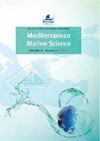加泰罗尼亚海岸(地中海西北部)软底生境的深度和沉积物粒度特征:意想不到的物种组合组成
IF 2.3
3区 环境科学与生态学
Q1 MARINE & FRESHWATER BIOLOGY
引用次数: 0
摘要
该研究的目的是描述加泰罗尼亚海岸3至35米深度的海洋软底栖息地的大型动物组成,考虑到所有大型无脊椎动物群体。该研究还旨在将我们的数据与先前关注地中海西北部的研究进行比较,并定义驱动组合组成的变量。根据物种组成和组合结构,描述了六种不同的栖息地,主要由深度和沉积物粒度定义。浅层(20 m)沉积物很容易区分,并分为三种类型:(1)非常粗和粗沉积物(粗沉积物);(2)中、细、极细砂(细沉积物);(3)泥质沉积物。浅水和深水中的细沉积物已经成为沿海35米深处最常见和最广泛的栖息地。既不粗糙也不泥泞的栖息地很常见。浅层生境的特征得出了一些意想不到的结果:Spisula subtruncata和Lucinella divaricata是优势多毛体,而之前提到的浅细沙生境优势多毛体Ditrupa arietina和Owenia fusiformis都不常见。除浅层细粒沉积物以软体动物为主外,6个生境中多毛类的物种丰富度和丰度均为优势类群。这项研究是未来对加泰罗尼亚海岸35米深的软底栖息地进行监测的基准。本文章由计算机程序翻译,如有差异,请以英文原文为准。
Species characterization of soft bottom habitats by depth and sediment particle size on the Catalan coast (NW Mediterranean): unexpected species composition of the assemblages
The aim of the study is to describe the macrofaunal composition of marine soft bottom habitats on the Catalan coast between a depth of 3 and 35 meters, considering all groups of macroinvertebrates. The study also aims to compare our data with previous studies focused on the NW Mediterranean and to define the variables that drive assemblage composition. Depending on the species composition and the structure of the assemblages, six different habitats, mainly defined by depth and sediment granulometry, are described. Shallow (<20 m) and deep (>20 m) habitats are easily distinguished and are subdivided in three habitats each: (1) very coarse and coarse sediments (coarse sediments); (2) medium, fine and very fine sands (fine sediments); and (3) muddy sediments. Fine sediments in both shallow and deep waters have emerged as the most common and extensive habitats along the coast up to a depth of 35 meters. Neither coarse nor muddy habitats are frequent. The characterization of shallow habitats produced some unexpected results with respect to previous studies: Spisula subtruncata and Lucinella divaricata were dominant, while neither Ditrupa arietina nor Owenia fusiformis, previously mentioned as dominant polychaetes in shallow fine sand habitats, were common. Polychaetes were, in general, the dominant group (both in species richness and abundance) in the six habitats, except in shallow fine sediments, which were dominated by mollusks. The study is a benchmark for future monitoring of soft bottom habitats on the Catalan coast to a depth of 35 meters.
求助全文
通过发布文献求助,成功后即可免费获取论文全文。
去求助
来源期刊

Mediterranean Marine Science
MARINE & FRESHWATER BIOLOGY-
CiteScore
5.20
自引率
17.90%
发文量
34
审稿时长
>12 weeks
期刊介绍:
The journal Mediterranean Marine Science (MMS), published by the Hellenic Centre for Marine Research (HCMR), issues three volumes annually. The journal welcomes original research articles, short communications, New Mediterranean Biodiversity records, extended reviews, comments, and Theme sections in all fields of Oceanography, Marine Biology, Marine Conservation, Fisheries and Aquaculture in the Mediterranean area and the adjacent regions. All content is peer reviewed.
 求助内容:
求助内容: 应助结果提醒方式:
应助结果提醒方式:


